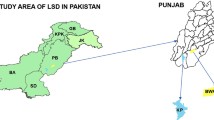Abstract
In previous studies, Theileria annulata surface protein (TaSP) was identified as an immunodominant antigen and successfully used to develop a recombinant-protein-based indirect enzyme-linked immunosorbent assay (ELISA) for the detection of circulating antibodies in serum of T. annulata-infected animals. To increase the specificity, a competitive ELISA (cELISA) was developed using recombinant TaSP antigen and a monoclonal antibody (1C7) specifically binding to TaSP. Since the cELISA accurately differentiated T. annulata-infected from uninfected animals, a study was performed to analyse the suitability of the cELISA in the field. For this, 230 sera with unknown status from different governorates in the north of Iraq were analysed using both the indirect and competitive ELISA and were compared. There was a significant (p < 0.5 × 10−19) correlation (r = 0.556) between the tests, whereby the cELISA detected more sera as negative (44/230) compared to the indirect ELISA (21/270). Accordingly, less sera were determined to be positive in the competitive (186/230) than in the indirect ELISA (209/230). Sensitivity and specificity of the cELISA taking the indirect ELISA as a reference were 84.2% and 52.4%, respectively. Accordingly, the calculated prevalence of T. annulata infection was 90.9%, and the positive predictive value was determined to be 94.6%. Taken together, the cELISA proved its suitability for field application and was found qualified for use in serological surveys to monitor the prevalence of T. annulata infection and to identify carrier animals.



Similar content being viewed by others
References
Ahmed JS, Rothert M, Steuber S, Schein E (1989) In vitro proliferative and cytotoxic responses of PBL from Theileria annulata-immune cattle. J Vet Med B 36:584–592
Al-Barwary, LTO (2007) A study on Hematological parameter, vector taxonomy and serological diagnosis on bovine piroplasmosis in Kurdistan. Dissertation, College of Vet. Med., University of Dohuk
Al-Saeed A (2009) Application of Polymerase Chain Reaction (PCR) for Detection of Theileria annulata among cattle in Kurdistan region/Iraq. Dissertation, College of Vet. Med., University of Dohuk
Bakheit MA, Schnittger L, Salih DA, Boguslawski K, Beyer D, Fadl M, Ahmed JS (2004) Application of the recombinant Theileria annulata surface protein in an indirect ELISA for the diagnosis of tropical theileriosis. Parasitol Res 92:299–302
Burridge MJ, Brown CGD, Kimber CD (1974) Theileria annulata: cross-reaction between a cell culture schizont antigen and antigen of East-Africa species in the indirect fluorescent antibody test. Exp Parasiol 35:374–380
Dolan TT (1989) Theileriosis: a comprehensive review. Rev Sci Tech Off Int Epiz 8:11–36
Gubbels JM, de Vos AP, van der Weide M, Viseras J, Schouls LM, de Vries E, Jongejan F (1999) Simultaneous detection of bovine Theileria and Babesia species by reverse line blot hybridization. J Clin Microbiol 37:1782–1789
d’Oliveira C, van der Weide M, Habela MA, Jacquiet P, Jongejan F (1995) Detection of Theileria annulata in blood samples of carrier cattle by PCR. J Clin Microbiol 13:2665–2669
Leiper JWG (1957) Report to Government of Iraq, on animal parasites and their control. FAO EPTA report no. 610-30
Omer LT, Kadir MA, Seitzer U, Ahmed JS (2007) A survey of ticks (Acari:Ixodidae) on cattle, sheep and goats in the Dohuk Governorate. Iraq Parasitol Res 101(Suppl 2):S179–S181
Renneker S, Kullmann B, Gerber S, Dobschanski J, Bakheit MA, Geysen D, Shiels B, Tait A, Ahmed JS, Seitzer U (2008) Development of a competitive ELISA for detection of Theileria annulata infection. Transbound Emerg Dis 55(5–6):249–256
Salih DA, Ahmed JS, Bakheit MA, Ali EB, El Hussein AM, Hassan SM, Shariff OE, Fadl M, Jongejan F (2005a) Validation of the indirect TaSP enzyme-linked immunosorbent assay for diagnosis of Theileria annulata infection in cattle. Parasitol Res 97:302–308
Salih D, Hassan S, Bakheit MA, El Hussein AM, Jongejan F, Ahmed JS (2005b) Application of the indirect TaSP enzyme-linked immunosorbent assay for diagnosis of Theileria annulata infection in cattle. In: Proceedings 5th International Conference on Ticks and Tick-Borne Pathogens. Neuchâtel, Switzerland, pp. 163–166
Salih DA, El Hussein AM, Kyule MN, Zessin KH, Ahmed JS, Seitzer U (2007a) Determination of potential risk factors associated with Theileria annulata and Theileria parva infections of cattle in the Sudan. Parasitol Res 101:1285–1288
Salih DA, Hassan SM, El Hussein AM (2007b) Comparisons among two serological tests and microscopic examination for the detection of Theileria annulata in cattle in northern Sudan. Prev Vet Med 81:323–326
Schnittger L, Katzer F, Biermann R, Shayan P, Boguslawski K, McKellar S, Beyer D, Shiels BR, Ahmed JS (2002) Characterization of a polymorphic Theileria annulata surface protein (TaSP) closely related to PIM of Theileria parva: implications for use in diagnostic tests and subunit vaccines. Mol Biochem Parasitol 120:247–256
Seitzer U, Bakheit MA, Salih DE, Ali A, Haller D, Yin H, Schnittger L, Ahmed JS (2007) From molecule to diagnostic tool: Theileria annulata surface protein TaSP. Parasitol Res 101:S217–S223
Shiels BR, McDougall C, Tait A, Brown CGD (1986) Identification of infection-associated antigens in Theileria annulata infected cells. Parasite Immunol 8:69–77
Acknowledgements
This study was supported in part by EU funded projects INCOME (515915), ICTTD-3 (510561). We would like to thank Andy Tait (Department of Veterinary Parasitology, Faculty of Veterinary Medicine, University of Glasgow) for kindly providing us with the 1C7 monoclonal antibody.
Ethical standards
The experiments performed in this study comply with the current laws of the country in which they were performed.
Conflict of interest
The authors declare that they have no conflict of interest.
Author information
Authors and Affiliations
Corresponding author
Additional information
Stefanie Renneker and Jassim Abdo contributed equally to the paper.
Rights and permissions
About this article
Cite this article
Renneker, S., Abdo, J., Ahmed, J.S. et al. Field validation of a competitive ELISA for detection of Theileria annulata infection. Parasitol Res 106, 47–53 (2009). https://doi.org/10.1007/s00436-009-1625-4
Received:
Accepted:
Published:
Issue Date:
DOI: https://doi.org/10.1007/s00436-009-1625-4




